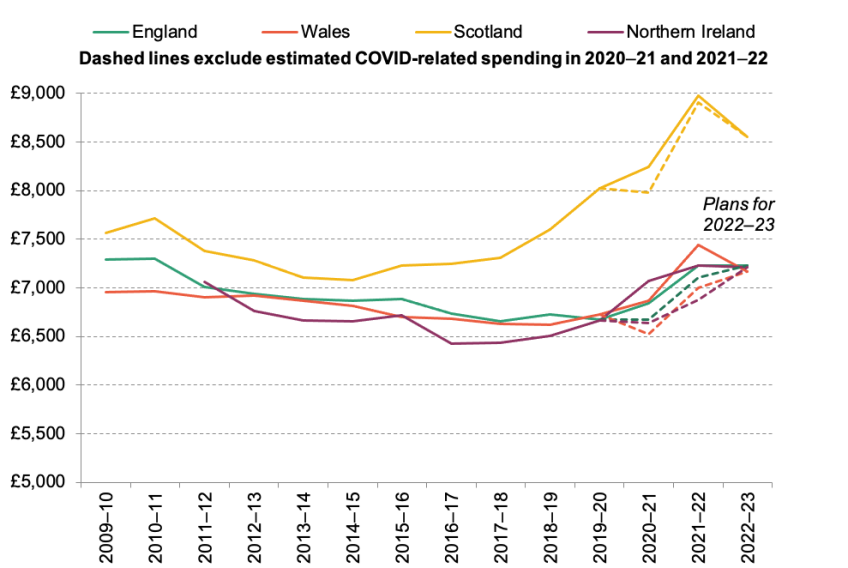
Scotland’s per-pupil spend highest in UK, but effects unclear

School spending per pupil is “significantly higher” in Scotland than in the rest of the UK, but it may be a number of years before it can be shown whether there has been any impact, research shows.
A report from the Institute for Fiscal Studies (IFS) today highlights that spending per pupil in Scotland is more than 18 per cent (£1,300) higher in 2022-23 than in England, Wales and Northern Ireland.
About £8,500 is spent per pupil in Scotland, compared with around £7,200 across the rest of the UK.
- Also this week: Exam reform report highlights Scottish teachers’ workload concerns
- Analysis: What do Humza Yousaf’s policy priorities tell us about education?
- Data: Scotland to rejoin Timss and Pirls international education surveys
The report shows that “school spending per pupil is broadly similar in England, Wales and Northern Ireland - though the three nations have seen very different pressures from changing pupil numbers” - while it is “now significantly higher in Scotland”.
The report does say, however, that “whilst we have sought to make these measures as comparable as possible, there are always potential limitations with comparing data from different sources”. For example, the Scottish and Welsh figures are “likely to increase as a result of agreements on teacher pay and expectations of extra funding to pay for these higher awards”, while that “could also apply to England and Northern Ireland when agreements are reached”.
The IFS report, funded by the Nuffield Foundation, says that spending in Scotland grew by 13 per cent in real terms between 2009-10 and 2022-23, partially reflecting funding to cover previous higher teacher pay deals.
Much of Scotland’s increased spend, however, has been driven by funding to almost double early years learning and childcare for all three- and four-year-olds and eligible two-year-olds.
This will take a “very long time to filter through to test scores or other educational outcomes”, the IFS says, and it remains unclear what the impact will be on Scotland’s key aim to significantly narrow attainment gaps between rich and poor.
It adds: “Nevertheless, it is noteworthy that despite having the highest level of school spending per pupil across the UK for a long period, test scores in reading, maths and science in Scotland have either stayed the same or been going down over time in Pisa (Programme for International Student Assessment) international comparisons.”
School spending per pupil across England, Wales, Scotland and Northern Ireland (2022-23 prices), actual and planned spending
 Graph: Institute for Fiscal Studies (sources here)
Graph: Institute for Fiscal Studies (sources here)
Report author Luke Sibieta, an IFS research fellow, said: “School spending per pupil in Scotland is now over 18 per cent higher than in the rest of the UK.
“This big gap mostly reflects less pressure from pupil numbers and relatively recent spending rises.
“It would be too soon to expect much of an effect on educational outcomes. However, spending per pupil in Scotland has been higher than in the rest of the UK for a long period and educational outcomes have continued to disappoint over the last decade.”
The report notes that “to some extent, school spending per pupil has been higher in Scotland for a long period” - although not at the current 18 per cent level - and adds: “Between 2009-10 and 2014-15, spending per pupil fell by 6.5 per cent in real terms in Scotland, mirroring the cuts occurring across the rest of the UK. These cuts were more than unwound, with spending per pupil growing by 13 per cent in real terms between 2014-15 and 2019-20.”
John Hillman, director of education at the Nuffield Foundation, said: “These figures show a wide and growing disparity in funding for pupils between Scotland and the other three nations of the UK, but it’s yet to be seen if the 18 per cent of higher spend on Scottish students is effective in helping to narrow the gap in inequalities or improve the life chances of young people.”
Pupil numbers have grown by 13 per cent in England since 2009-10 and by 8 per cent in Northern Ireland since 2011-12, compared with - since 2009-10 - 2 per cent in Scotland and 3 per cent in Wales.
However, it is forecast that pupil numbers could fall by 6-8 per cent across all four UK nations in the next five years.
The report also shows that all four UK nations provided extra funding to schools to help with extra costs and to aid education recovery during and after Covid lockdowns.
It states: “We estimate that total Covid-related spending on schools across 2020-21 and 2021-22 was highest in Wales and Northern Ireland, at about £800 per pupil in total across the two years. It was lower in England and Scotland, at about £300 per pupil, though the figure for Scotland may be a slight underestimate due to extra funding through the main local government settlement.”
A Scottish government spokesperson said that the IFS findings “underline the Scottish government’s commitment to education investment with spending per pupil £1,300 higher than elsewhere in the UK after this increased in Scotland by 21 per cent between 2014-15 and 2022-23”.
The spokesperson talked up certain Achievement Curriculum for Excellence (ACEL) statistics. In December Tes Scotland reported that these key measures of literacy and numeracy in Scottish schools had gone in the right direction after record lows in 2021, but still not recovered to pre-pandemic levels.
“We have seen significant improvements in attainment, with a record increase in the proportion of primary school pupils achieving the expected levels of literacy (up 3.7 percentage points to 70.5 per cent) and numeracy (up 3.3 percentage points to 77.9 per cent), according to the most recent ACEL statistics,” the Scottish government spokesperson said.
“The latest Higher Education Student Statistics also showed that we had 33,880 Scottish-domiciled full-time first-degree entrants at our universities in the 2021-22 academic year - a 31.4 per cent increase since 2006-07.
“We know there is more to do, which is why we are investing a record £1 billion over this [2021-26] Parliament term into the Scottish Attainment Challenge. This empowers schools and councils to improve the attainment of pupils impacted by poverty.”
You need a Tes subscription to read this article
Subscribe now to read this article and get other subscriber-only content:
- Unlimited access to all Tes magazine content
- Exclusive subscriber-only stories
- Award-winning email newsletters
- Unlimited access to all Tes magazine content
- Exclusive subscriber-only stories
- Award-winning email newsletters
You need a subscription to read this article
Subscribe now to read this article and get other subscriber-only content, including:
- Unlimited access to all Tes magazine content
- Exclusive subscriber-only stories
- Award-winning email newsletters
- Unlimited access to all Tes magazine content
- Exclusive subscriber-only stories
- Award-winning email newsletters



